What Is a Project in Project Management? Definition, Examples, and More
What is a project? The question’s so simple you’ve probably never thought to ask it.
At face value, everyone knows what a project is. But as any project manager can tell you, once your role is to think about them deeply, you’ll quickly realize that projects aren’t quite so simple.
Projects are filled with moving elements — people, skills, budgets — that all must be aligned to reach a successful outcome.
These elements are easy to understand theoretically. Mastering them in practice, and knowing which strategies to fall back on when your projects face real-life hurdles, is another challenge altogether.
This article will break projects down into first principles, offering beginner and seasoned project managers alike a holistic view of project elements and how to manage them.
What’s the definition of a project?
Boiled down, a project is a sequence of activities geared toward a predetermined result.
Projects are always structured with a known end goal and have specific milestones that must be reached along the path to that goal. They’re typically characterized by their temporary nature, and they require the project team to deliver a set of objectives within a set budget and timeframe.
How projects are managed depends on the size of the group undertaking it. In a small team of creative collaborators, projects might be managed collectively. In a 10-person startup, the founder or an executive might take on project management duties in addition to their regular commitments.
Larger organizations will typically have dedicated project managers, while a solo freelancer might need to take on project management responsibilities on top of the work they need to deliver.
Typical project characteristics
Projects are made up of activities. Activities are a series of planned actions intended to accomplish the project’s goals.
Project activities are distinct from ordinary, operational activities because they are temporary, and undertaken for a defined set of time to produce a narrow, specified result.
Properly aligned project activities are designed to produce results that gradually move the project forward until it meets its final objective.

Clear timeline with a start and end date
The defined beginning and end points of a project are often visualized through a project timeline. Projects are finite, so the timeline ensures key project components are delivered on dates that enable the overall project to be completed on time. These delivery dates are called deadlines.
Ideally, key results get delivered on those planned deadlines. However, project managers sometimes need to adjust deadlines to implement contingency measures like resource leveling.
Larger projects often have scores of people delivering work on many differing deadlines. Scheduling tools offer project managers a way to keep organized and stay tapped into when the next deliverable should hit their inbox.
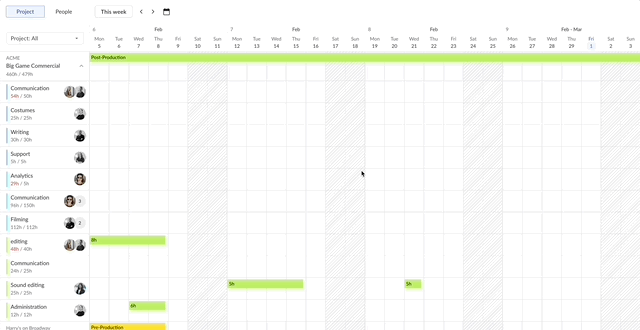
Timeline-view planner in Rodeo Drive
Follows a set project plan
Before a project begins, project managers will write a project plan. A project plan roadmaps all the steps a project must take to reach a successful outcome. This includes objectives, how those objectives will be achieved, and what resources should be used to achieve them.
Project managers are also responsible for consulting with key stakeholders during the planning stage. Often, these stakeholders don’t participate in project execution, so getting their input at the planning stage ensures that the project unfolds in alignment with their needs.
Once the project plan is completed, it is used as a reference throughout the execution phase of the project lifecycle. Plans are, of course, flexible and subject to change. But they also keep projects structured around their most important parameters.
When everyone knows what these parameters are, later changes are more deliberate and less prone to deviating from the project's core objectives. Some organizations even have change control boards, which evaluate whether proposed changes align with the project’s intended scope.
Progresses through the project lifecycle
Successful projects tend to move through a common set of stages, which are referred to as the project lifecycle. Following the lifecycle keeps projects organized and reduces risks. Additionally, success at each stage of the lifecycle increases the odds that the next stage goes off without issue.
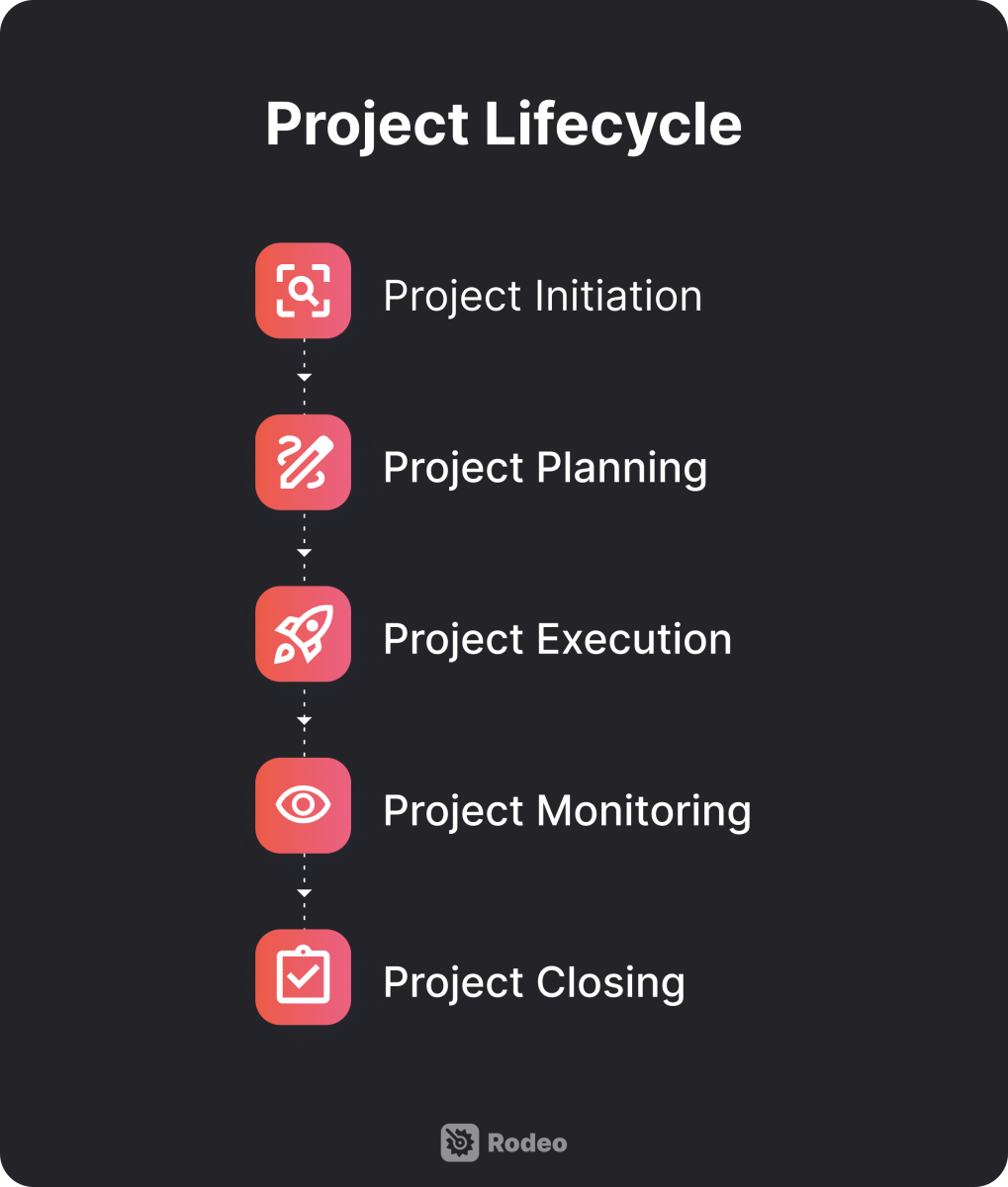
Stage 1: Project initiation
The initiation stage is about laying the groundwork. It means identifying the purpose and objectives of the project and conducting a feasibility study to determine whether those objectives are achievable.
During the initiation phase, the project manager engages with stakeholder expectations and builds consensus on the direction of the project, before moving on to planning.
Stage 2: Project planning
Planning means defining project deliverables, developing schedules, and allocating resources. This is the stage where project managers set milestones and realistic, achievable goals for the project.
Depending on the industry or the nature of the project, the project leader might also need to create a risk register, outlining planned responses to probable setbacks. A successful planning stage will result in a clear framework for how the project will be completed given its constraints.
Stage 3: Project execution
Execution is the phase where the project plan is put into action. It’s the most visible stage, where team members complete activities, coordinate, and deliver results.
Stage 4: Project monitoring and controlling
Dedicated project managers are usually hands-off with executing project activities. But, their hands are usually full with monitoring and controlling. It’s a little misleading to call monitoring and controlling a fourth stage since it happens in tandem with the execution phase of a project.
Once a project is underway, project managers shift their focus from planning to making sure the project proceeds smoothly. That means measuring performance, managing any changes to initial plans, and resolving issues that come up.
Monitoring is a proactive, ongoing process. It ensures that potential setbacks are identified and resolved before they turn into larger problems. Effective controlling guides projects back to planned parameters when they start to veer off track. That way, objectives are met as closely as possible, within defined constraints.
Stage 5: Project closing
Closing is the final stage, where the project is formally completed. When a project is closed, deliverables are handed over to clients or relevant stakeholders, and resources are released for other operations.
This stage might also involve receiving feedback from clients, conducting post-project evaluations, documenting lessons learned, and incorporating revisions should certain deliverables not meet expectations.
The 3 project constraints: time, scope, and cost
Time, scope, and cost are dubbed the “triple constraint” in project management. Here is how each resource constraint is defined:
- Time is the length of the project schedule. It dictates the pace of work and activities, forcing project managers to prioritize the most important.
- Scope is the project objective and all its deliverables. A scope statement sets the boundaries of the project. It determines where effort should go and what changes are permissible once the project is ongoing.
- Cost refers to the budget and resources (including people) that a business commits to completing a project. In the context of project management, it’s more similar to the idea of an opportunity cost, rather than being strictly limited to financial costs.
Projects succeed or fail based on how these elements are managed. It’s a simple idea, but 36% of project managers don’t engage in risk management, which can mitigate the chances that projects meet roadblocks because of the triple constraints.
Because these constraints are interdependent, when problems arise with one constraint, the others are affected. If the project budget is exceeded, the schedule risks being delayed. When the project scope gets too large, costs end up ballooning.
Project managers need to maintain a careful balance between each of these elements to lead successful projects. Software solutions like Rodeo Drive can help you do just that. The platform’s timeline-view activity planner allows project managers to keep a handle on their time constraints and project scope, for example.
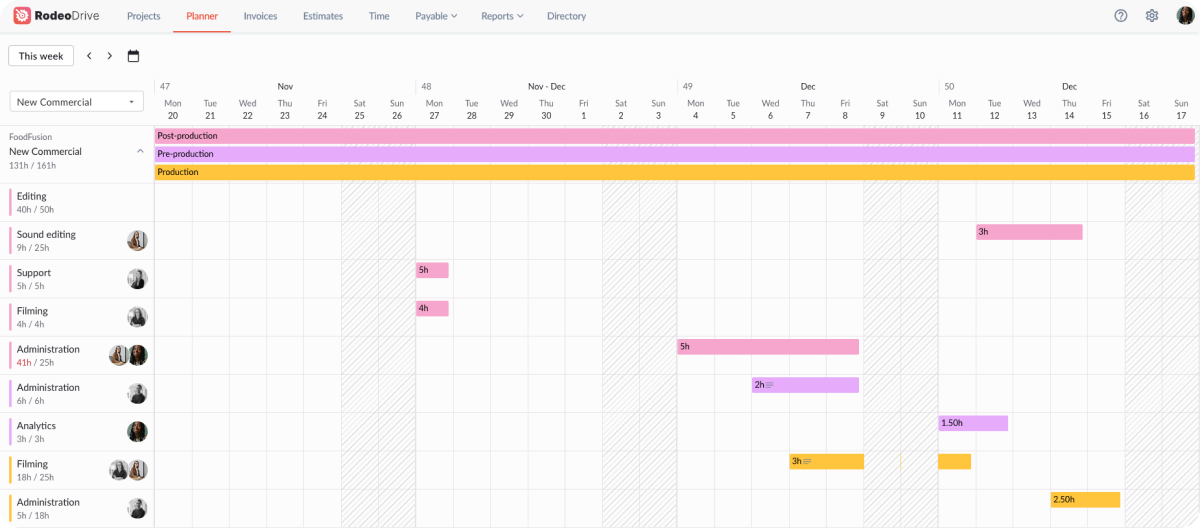
Plan project activities and manage your team’s workload capacity using Rodeo Drive’s planner
Obstacles to successful projects
Project obstacles are blockers that stop project plans from progressing as expected. Some are industry-specific, while some are universal to managing projects. Examples of the latter include planned resources becoming unavailable, scope creep, stakeholder conflict, and budget overruns.
Let’s explore each of these obstacles:
- Scope creep: Changes in project scope without corresponding adjustments to time, cost, and resources.
- Budget overrun: Exceeding the planned budget because of unforeseen costs or poor estimations.
- Stakeholder conflict: Differing or conflicting interests among project stakeholders confusing direction.
- Resource constraints: Limited availability or sudden unavailability of necessary resources, including personnel, equipment, and materials.
The goal of project management is to address obstacles as they arise so that projects can ultimately succeed.

So, what’s project management?
Project management is the discipline of smoothly navigating projects through each stage of their lifecycle.
Project management is definitely an art, but it is also part science — it has conventions, common methodologies, and knowledge that are used across the profession to achieve project success.
What does a project manager do?
Project managers steward projects so that they meet defined goals and objectives. They take care of the project’s administrative work so that team members can focus on execution. Project managers also mediate, coordinate, and lead where needed, guiding projects through each stage of the lifecycle.
Project management responsibilities include:
- Developing the project plan and ensuring its execution
- Managing project teams while coordinating with stakeholders
- Monitoring project progress to make timely adjustments when needed
- Resolving conflicts, and addressing concerns that arise during the project.
In many organizations, project managers are also responsible for resource management. In a nutshell, this means they need to pick the appropriate team members to fulfill project roles. This is known as resource allocation. When allocating resources, project managers must consider relevant skills and how team members are already tied to other ongoing projects.
A project manager’s capacity to problem-solve and adapt to changing circumstances significantly influences project success. While domain experts are responsible for completing milestones and are therefore critical, project managers can facilitate collaboration between them and reduce the friction around their work.
Also read: A Comprehensive Guide on How to Become a Project Manager
Project examples by industry
Projects look a little different based on industry context. Here are some general examples to illustrate some of the different forms projects might take depending on the industry environment:
Marketing projects
Marketing projects tend to be structured around campaigns and brand initiatives. They blend strategic planning, creativity, and measurement. Marketing teams often need to work around project parameters set by stakeholders in other parts of their organization.
A marketing campaign might look like supporting the launch of a new product, conducting research on user preferences, or developing digital ads.
These projects demand a deep investigation of the target audience, understanding trends, and finding appropriate communication channels.
Related: How to Set Marketing OKRs in 10 Steps

Agency projects
Creative agencies typically operate projects using cross-functional teams. An agency running a brand redesign effort, for example, might need to coordinate strategists, designers, and copywriters on different teams to complete project deliverables.
Additionally, since agencies conduct client-focused work, their initiation and planning phases might have more emphasis on incorporating client input.
Due to that client focus, on-time project completion also takes on greater importance in an agency environment.
Software development
Key challenges for software projects include managing complexity, ensuring quality, and adapting to changing requirements.
A software project, like the rollout of a feature, might need to go through several iterations and incorporate feedback from users and key stakeholders in the organization before it can be deployed.
Software teams tend to prefer agile project frameworks because they meets these particular challenges. Agile project management is iterative and encourages adaptation to feedback.
Project management methodology overview
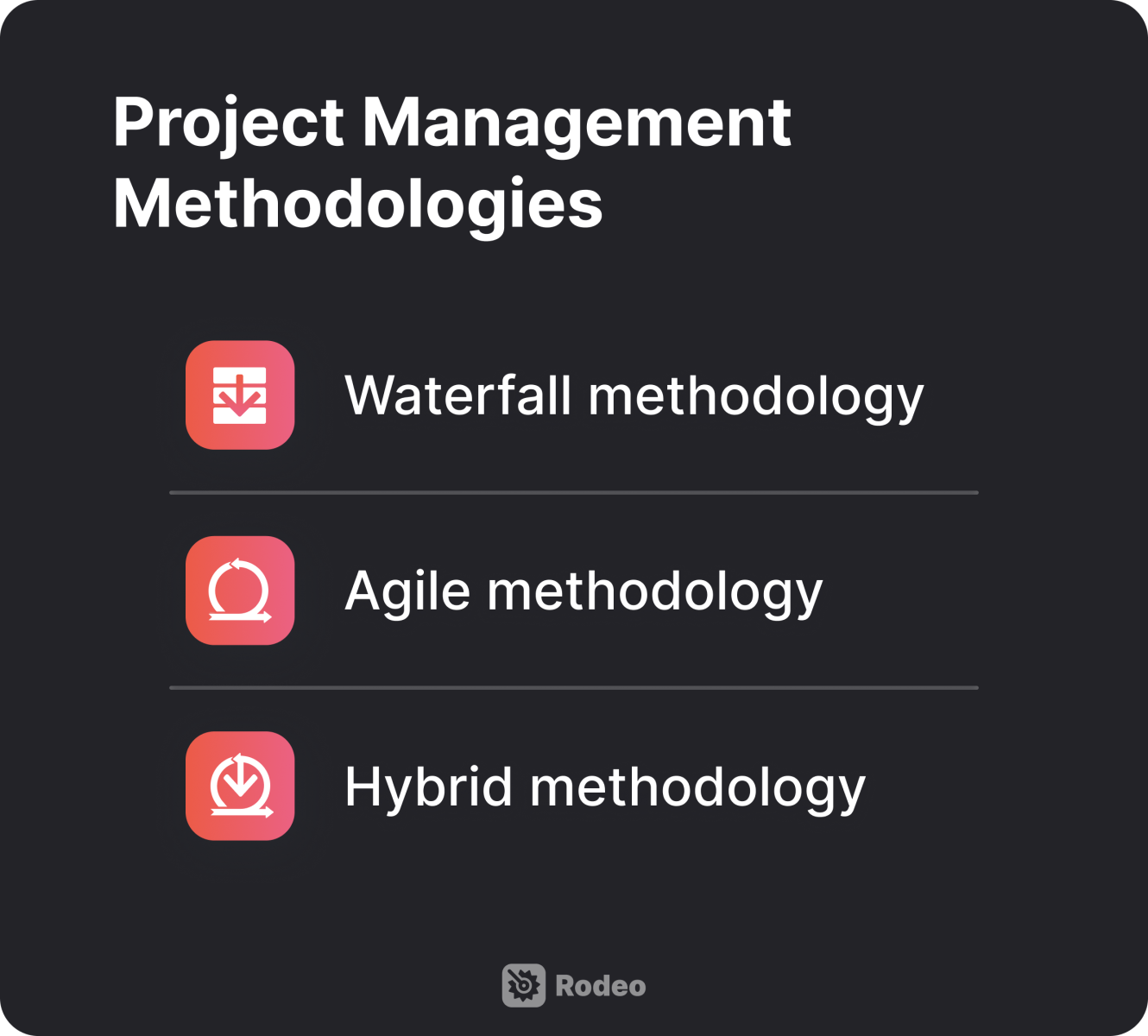
Only 58% of projects follow a defined methodology. This may explain why only 29% of organizations complete most of their projects on time and only 47% say they have a track record of project success.
Using project management software and having a standardized but flexible project management methodology increases the chances of project success.
Project management methodologies are deep enough to warrant a whole dedicated article, so we’ll just offer a cursory glance at three of the most common ones here.
Also read: Top 12 Project Management Methodologies to Keep Teams on Track
Waterfall methodology
This is a traditional, sequential approach best suited for projects with well-defined requirements and a direct path to completion. The waterfall approach follows, fittingly, a linear flow — each phase must be completed before the next begins.
Construction projects are examples of waterfall projects. A highrise project starts with the foundation and builds up, one floor at a time, following the blueprint. For the next floor to start construction, the previous one must be laid out first.
Agile methodology
Agile is a flexible, iteration-based approach. It’s ideal for projects that need frequent reassessment. Agile projects are characterized by sprints, which are short phases where work is completed and prepared for review.
While the overall project might run for eight months, for instance, sprints typically run from two weeks to a month. Sprints are meant to divide the project into smaller, more manageable deliverables.
The controlled goals and time-sensitive nature of agile sprints encourage project progression. People have a natural sense of urgency when goals are immediate and concrete, rather than abstract and set for five months down the road.
Agile projects also use daily standups to encourage communication and accountability. During standups, team members report on their progress, bring up roadblocks, and ask other team members for assistance where needed.
Hybrid methodology
Hybrid methodologies combine components of Agile and waterfall. Hybrid projects might be planned using a waterfall approach, but executed using agile techniques.
In practice, this might look like planning the project with linear phases and deadlines, and then breaking down those phases and deadline deliverables into tasks that can be completed within a week.
The project timeline can also be divided into two-week sprints, with updates on prioritized items at the end of every sprint.
Optimize your project management processes with Rodeo Drive
There’s no better complement to great project management than powerful project management software.
Rodeo Drive is the go-to for hundreds of project leaders who champion successful projects. Here’s how it helps them achieve their goals:
Organized project timelines and activity planning
Rodeo Drive’s timeline-view planner lets you assign and oversee activities for all your ongoing projects. With the planner, you can view all your projects at once to identify scheduling conflicts or filter down to individual projects for a focused planning workflow.

Rodeo Drive’s planner ensures all project activities are properly assigned and scheduled
Automated reporting and visibility
Project managers love the visibility Rodeo Drive gives them over project finances, team productivity, and time spent on project activities. It features automated reporting for all three.
The Projects report in Rodeo Drive provides a holistic view of planned versus actual budget costs, expenses, invoices, and time allocations.
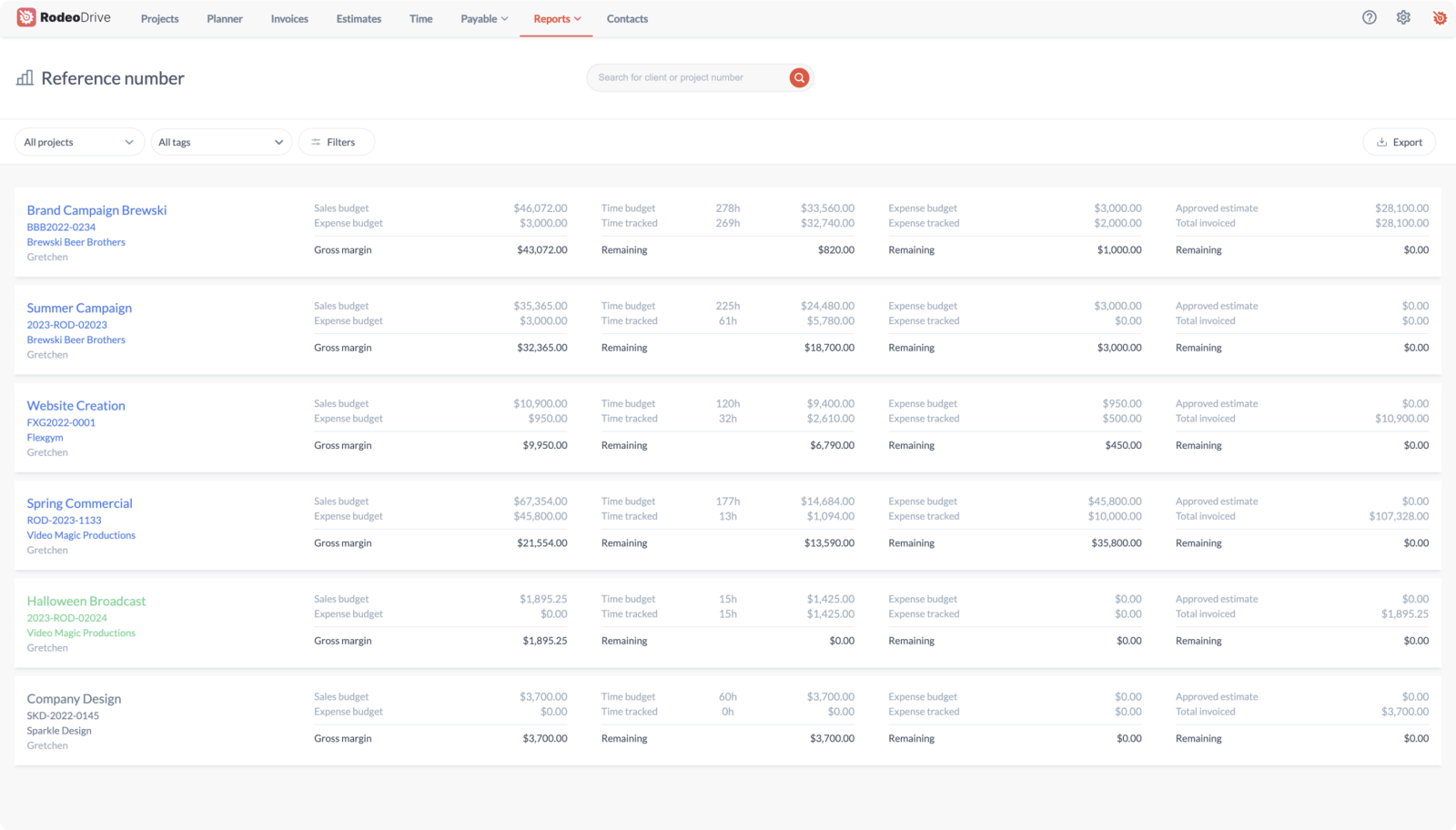 See the financial health of all your projects in a single report
See the financial health of all your projects in a single report
The Time report lets you know which project phases and activities are demanding attention from your team, and how much those activities are costing.
.png)
Identify where time is going — and understand its cost
Finally, the Productivity report gives you insight into how many hours your team members have scheduled on projects, letting you find availability and avoid overwork.
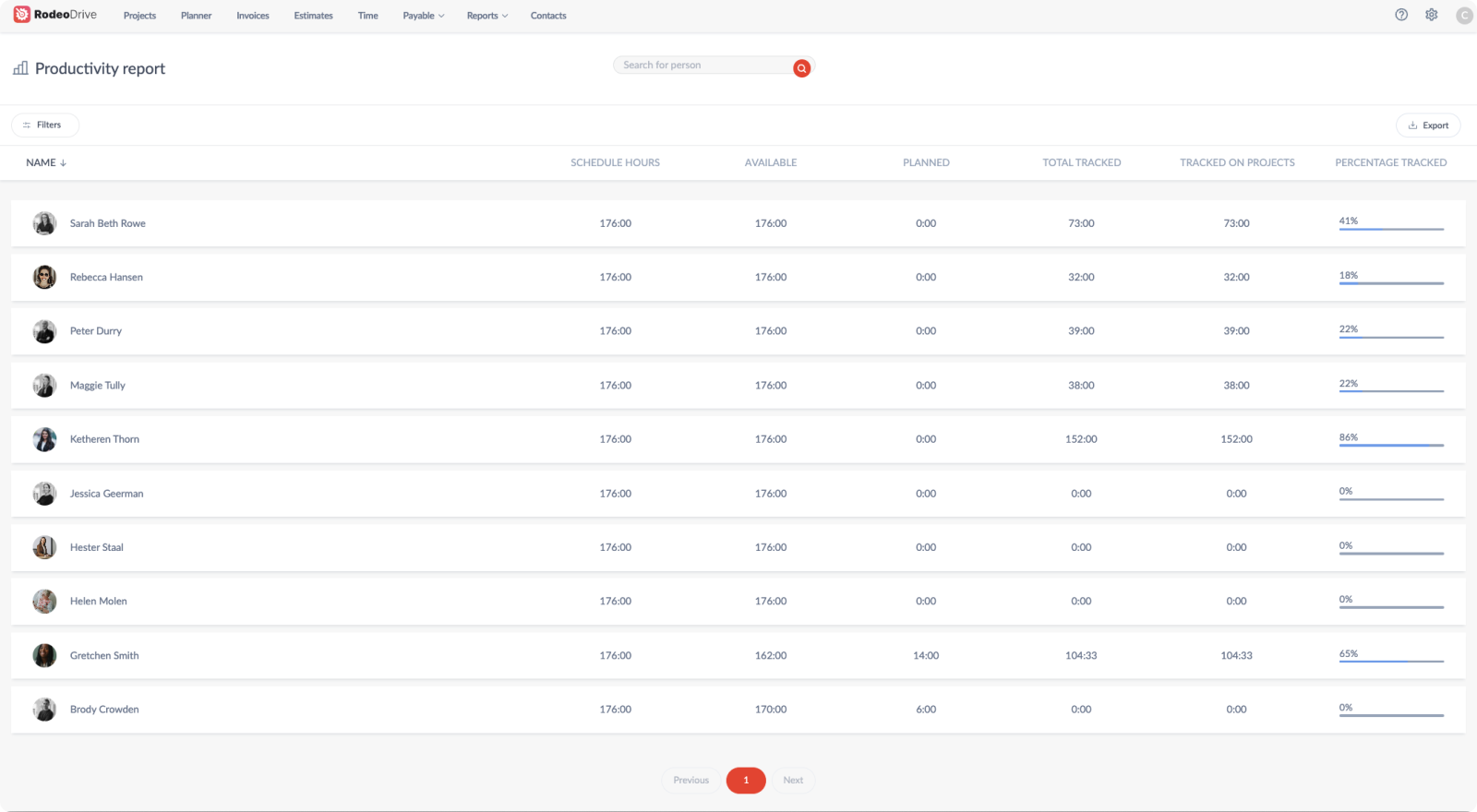
Keep tabs on your team’s billable rate using the Productivity report
Better project budgets for maximized profits
The better your budget planning, the more successful your projects. Projects achieve better profitability when project managers can account for their true costs from the beginning.
With Rodeo Drive, you don’t need to be a financial wizard to make that happen. All you have to do is input the rates of your time activities and project expenses. Then, Rodeo Drive will take care of the rest.

Factor in the price of activities in the planning phase for accurate pricing down the line
Make your next project a hit. Start using Rodeo Drive for free — no credit card required.








